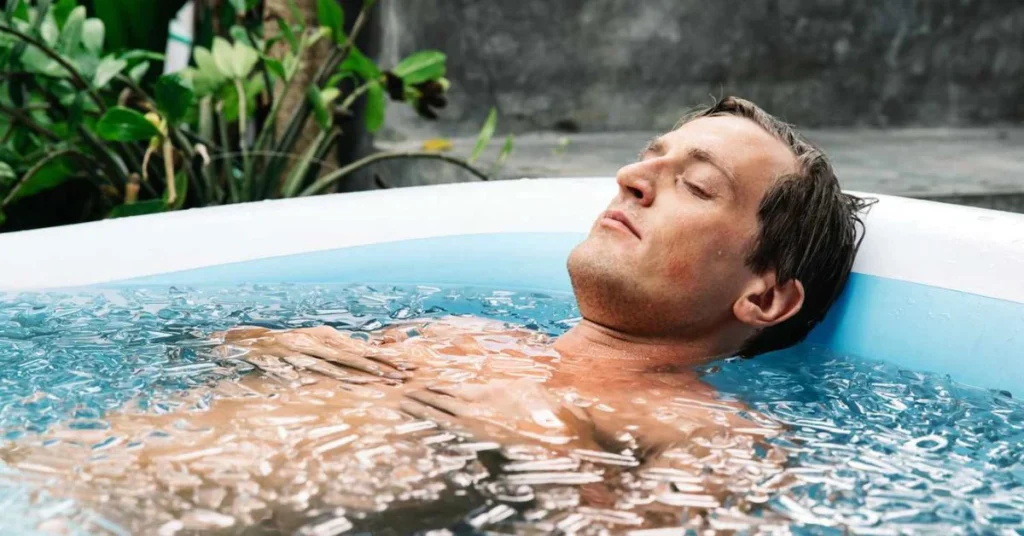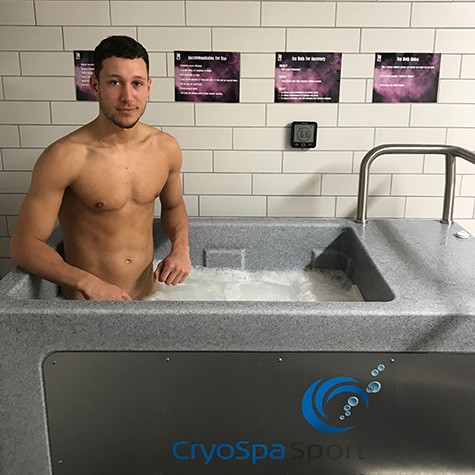What is a Cold Plunge Tub is a rising questions in the minds. In the pursuit of holistic well-being, individuals are increasingly turning to unconventional yet highly effective methods to enhance their physical and mental health. One such intriguing avenue is the cold plunge tub—a therapeutic experience that goes beyond the typical spa treatment. This article delves into the world of cold plunge tubs, unraveling the numerous benefits and providing insights into the rejuvenating effects they offer.

Understanding Cold Plunge Tubs:
Definition and Origin:
A cold plunge tub is a specially designed cold-water bath that traces its roots back to ancient wellness practices. Historically, cold water immersion has been used in various cultures for its purported health benefits.
Design and Structure:
Explore the anatomy of a cold plunge tub, discussing its construction, materials used, and the incorporation of modern technologies for an optimal chilling experience.
Health Benefits of Cold Plunge Baths:

Improved Circulation:
Cold water immersion is known to stimulate blood flow, aiding in better circulation throughout the body. This can contribute to enhanced cardiovascular health and reduced inflammation.
Muscle Recovery:
Athletes and fitness enthusiasts often turn to cold plunge tubs to accelerate muscle recovery and alleviate soreness. The cold water helps reduce muscle swelling and inflammation.

Stress Relief and Mental Clarity:
Cold immersion is linked to the release of endorphins, promoting a sense of well-being and reducing stress. Explore the psychological benefits and its impact on mental clarity.
Therapeutic Applications:

Spa and Wellness Centers:
Cold plunge tubs have found a place in high-end spas and wellness centers, offering patrons a unique and invigorating experience.
Home Installations:
Discuss the growing trend of individuals incorporating cold plunge tubs into their homes, exploring the different models and sizes available in the market.
Cultural and Historical Significance:
Ancient Practices:
Examine how various cultures, from the ancient Romans with their frigidariums to the Japanese practice of shinrin-yoku (forest bathing), have embraced the benefits of cold water immersion.
Rituals and Traditions:
Uncover rituals and traditions associated with cold water immersion in different societies, shedding light on the cultural significance of this practice.
Practical Considerations and Safety Measures:

Temperature Settings:
Discuss the optimal temperature range for a cold plunge, ensuring that users strike a balance between reaping the benefits and avoiding potential health risks.
Duration and Frequency:
Provide guidelines on how long individuals should stay in a cold plunge tub and the recommended frequency of sessions for maximum effectiveness.
Conclusion: As the popularity of cold plunge tubs continues to rise, it’s clear that this ancient practice is making a modern resurgence. Whether seeking muscle recovery, stress relief, or a unique spa experience, individuals are discovering the myriad benefits that cold plunge baths can offer on their journey to holistic wellness. Embracing the chill might just be the key to unlocking a revitalized and invigorated self.
Popular Brands of Cold Plunge Tub available in the market with their Specification.
ThermaSpas Arctic Spas:
Specification:
Material: High-quality acrylic with durable fiberglass reinforcement.
Size: Available in various sizes to accommodate individual preferences and space constraints.
Temperature Control: Precise digital temperature controls allow users to set and maintain their desired cold plunge temperature.
Jets: Built-in hydrotherapy jets enhance the chilling experience, providing a massage-like sensation.
Design: Sleek and modern designs with customizable options for aesthetics and functionality.
Polar Plunge by Master Spas:

Specification:
Construction: Robust, rotationally molded polyethylene for durability and insulation.
Size: Options range from compact models suitable for home use to larger designs for commercial settings.
Chiller System: Utilizes a dedicated chilling system to maintain consistently low water temperatures.
Accessibility Features: Some models include easy-entry steps and grab bars for accessibility and safety.
Energy Efficiency: Designed with energy-efficient features to minimize operational costs.
Cold Plunge Pools by WECO:

Specification:
Material: High-quality acrylic with durable fiberglass reinforcement.
Size: Available in various sizes to accommodate individual preferences and space constraints.
Temperature Control: Precise digital temperature controls allow users to set and maintain their desired cold plunge temperature.
Jets: Built-in hydrotherapy jets enhance the chilling experience, providing a massage-like sensation.
Design: Sleek and modern designs with customizable options for aesthetics and functionality.

Glacier Spas Cold Plunge Tubs:
Specification:
Shell Material: Acrylic with multi-layered fiberglass reinforcement for durability.
Temperature Range: Adjustable temperature settings to cater to various user preferences.
Jets and Massage Features: Incorporates hydrotherapy jets and massage options for a more immersive experience.
Control Panel: Intuitive digital control panels for easy temperature adjustment and system operation.
Compact Designs: Offers space-saving models suitable for smaller areas or home installations.
CryoSpas by CryoAction:

Specification:
Purpose-Built: Specifically designed for cold plunge therapy, catering to the needs of athletes and fitness enthusiasts.
Temperature Management: Advanced temperature control technology for precise and rapid cooling.
Portability: Some models are designed to be portable, allowing for easy relocation and flexibility in usage.
Integration with Health Monitoring: Some units may include features that integrate with health monitoring devices for a comprehensive wellness experience.
Before making a purchase decision, it’s crucial to consider factors such as size, materials, temperature control, and additional features based on individual preferences and requirements. Additionally, reading customer reviews and seeking recommendations can provide valuable insights into the performance and durability of these cold plunge tubs.
Difference between Cryotherapy and Ice Bath

Cryotherapy and ice baths are both popular therapeutic techniques used to promote recovery and alleviate muscle soreness, but they differ in their application, temperature, and physiological effects.
Temperature Range:
- Cryotherapy: Involves exposure to extremely low temperatures, typically ranging from -200°F to -250°F (-129°C to -157°C). This technique utilizes liquid nitrogen or refrigerated cold air to create a controlled and intense cold environment.
- Ice Baths: Entail immersion in water containing ice, usually with temperatures ranging from 50°F to 59°F (10°C to 15°C). While colder than room temperature, ice baths are not as extreme as cryotherapy in terms of temperature.
Duration of Exposure:
- Cryotherapy: Sessions are relatively short, typically lasting around 2 to 4 minutes. The brief exposure to extreme cold is believed to trigger a systemic response in the body.
- Ice Baths: Generally require longer duration, typically 10 to 20 minutes. The gradual cooling effect is achieved through prolonged immersion in the cold water.
Mechanism of Action:
- Cryotherapy: Aims to induce vasoconstriction (narrowing of blood vessels) and reduce blood flow to the extremities. This is followed by vasodilation once the individual returns to normal temperatures, promoting improved circulation and potential anti-inflammatory effects.
- Ice Baths: Work by constricting blood vessels during immersion and then allowing them to dilate upon rewarming. It is believed that the cold temperature lessens discomfort in the muscles and inflammation.

Application Method:
- Cryotherapy: Often administered in specialized cryo chambers or cryo saunas, where individuals are exposed to the extreme cold in a controlled environment. Localized cryotherapy is also possible for targeting specific body parts.
- Ice Baths: Involve submerging the entire body or specific areas in a tub filled with cold water and ice.
Tolerance and Comfort:
- Cryotherapy: Can be challenging for some individuals due to the intense cold, and it requires acclimatization to the low temperatures. Protective measures, such as wearing gloves and socks, are commonly used.
- Ice Baths: Tend to be more tolerable for many individuals, although the initial shock of cold immersion can still be uncomfortable. Users may gradually acclimate to the sensation over time.
Accessibility:
- Cryotherapy: Typically available in specialized facilities, such as cryo spas or wellness centers, which may limit its accessibility for some individuals.
- Ice Baths: Can be easily set up at home or in training facilities, providing a more accessible and cost-effective option.
In conclusion, while both cryotherapy and ice baths share the goal of aiding recovery through cold exposure, their distinct temperature ranges, duration, and application methods result in unique physiological responses. The choice between the two often depends on individual preferences, availability, and specific therapeutic goals.
For more information Contact Us. Our team is there to reply you.
Frequently Asked Questions (FAQs)
1. What is a cold plunge tub, and how does it differ from a regular cold bath?
A cold plunge tub is a specialized cold-water bath designed for therapeutic purposes, often exceeding the typical temperature of a standard cold bath. While both involve cold immersion, a cold plunge tub is engineered to provide a more controlled and invigorating experience, promoting various health benefits.
2. What are the key health benefits of using a cold plunge tub?
Cold plunge tubs offer a range of health benefits, including improved circulation, accelerated muscle recovery, stress relief, and mental clarity. The cold water immersion stimulates blood flow, reduces inflammation, and releases endorphins, contributing to overall well-being.
3. Are cold plunge tubs suitable for home use, or are they primarily found in spas?
Cold plunge tubs are increasingly popular for home installations. Many brands offer compact designs suitable for residential spaces, allowing individuals to enjoy the benefits of cold water immersion in the comfort of their homes. However, they are also prevalent in high-end spas and wellness centers.
4. What is the ideal temperature for a cold plunge, and can it be adjusted?
The ideal temperature for a cold plunge typically ranges between 45 to 55 degrees Fahrenheit (7 to 13 degrees Celsius). Most cold plunge tubs come with digital temperature controls, allowing users to adjust and maintain the water temperature according to their preferences and comfort levels.
5. How long should a session in a cold plunge tub last, and how often can it be done?
The duration of a session in a cold plunge tub can vary, but it is generally recommended to start with shorter sessions of around 5-10 minutes and gradually increase as tolerance builds. The frequency of sessions can range from daily to a few times per week, depending on individual needs and fitness goals.
6. Can cold plunge tubs be used for muscle recovery after intense physical activity?
Yes, cold plunge tubs are widely recognized for their effectiveness in muscle recovery. The cold water helps reduce muscle soreness and inflammation, making them a popular choice among athletes and fitness enthusiasts looking to expedite the recovery process after intense workouts.
7. Are there any safety considerations when using cold plunge tubs?
It’s necessary to adhere to the manufacturer’s safety instructions. Users should be aware of the recommended temperature settings, session durations, and any specific safety features of the cold plunge tub. Individuals with existing health conditions should consult with a healthcare professional before incorporating cold water immersion into their routine.
8. Do cold plunge tubs come with additional features, such as jets or lighting?
Many cold plunge tubs are equipped with hydrotherapy jets for a massage-like experience and may also feature customizable LED lighting for added ambiance. The availability of these features can vary between models and brands, so it’s advisable to explore different options based on individual preferences.
9. Can cold plunge tubs be installed outdoors?
Yes, several cold plunge tubs are designed for outdoor installations. The materials used in their construction are often weather-resistant, ensuring durability and longevity in various environmental conditions. However, users should consider factors like insulation and maintenance requirements for outdoor installations.
10. Are cold plunge tubs suitable for all ages and fitness levels?
Cold plunge tubs can be used by individuals of various ages and fitness levels. However, it’s recommended to start with shorter sessions and lower temperatures for beginners. Pregnant individuals and those with certain health conditions should consult with a healthcare professional before using cold plunge tubs.

